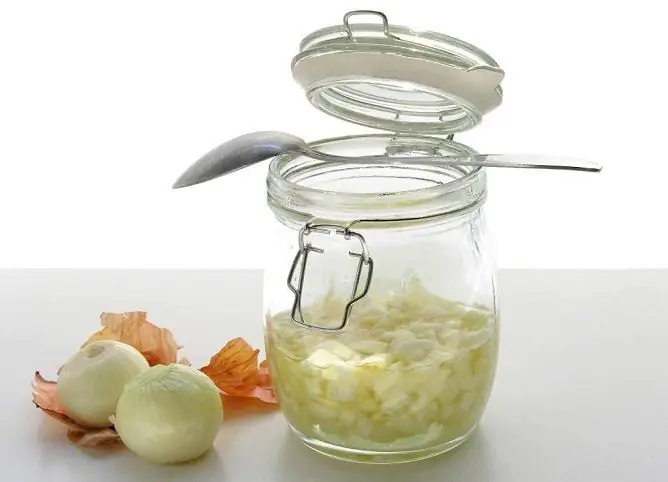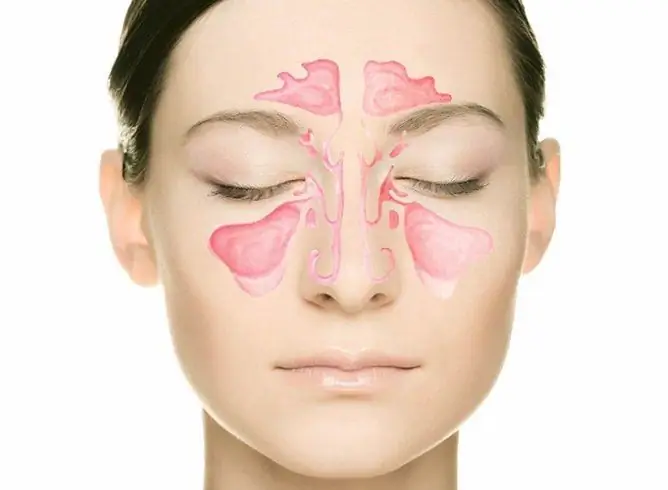- Author Rachel Wainwright [email protected].
- Public 2023-12-15 07:39.
- Last modified 2025-11-02 20:14.
Treatment of sinusitis at home in adults: effective remedies
The content of the article:
- Why does sinusitis occur and how does it manifest
-
How to treat sinusitis at home
- Flushing with sinusitis
- Nasal drops
- Oils
- Inhalation
- Ointments
- Other methods
- Complications of sinusitis
- Video
Sinusitis is an inflammatory process that affects the mucous membrane of the maxillary maxillary sinuses. The disease can be unilateral or bilateral, and other paranasal cavities may be involved in the process.

Most often, sinusitis is treated at home, hospitalization may be required for severe forms of the disease
In the course of the process, sinusitis is divided into acute and chronic. In the first case, antibiotics are most often required. The acute form of the disease, subject to the doctor's prescriptions, responds well to treatment, which eliminates the transition to the chronic form.
The symptoms of chronic sinusitis are less pronounced than in the acute course, but getting rid of the disease is quite difficult. Frequent exacerbations are observed, which significantly affects the patient's quality of life and may require antibiotics. At the same time, it will not be possible to cure sinusitis forever, colds and immunity disorders can lead to an exacerbation.
Why does sinusitis occur and how does it manifest
The acute form of the disease develops as a result of blockage of the outlet of the maxillary sinus, which leads to inflammation of its mucous membrane and accumulation of pus.
Possible reasons for the development of acute sinusitis:
- bacterial or viral infection. Pathogenic microorganisms can penetrate into the area of the maxillary sinuses from the nasal cavity, from teeth affected by caries or through the blood from chronic foci of infection with tonsillitis or pharyngitis;
- disorders of the immune system;
- injury to the nose or curvature of the nasal septum;
- allergic reactions in which nasal breathing is impaired.
Before treating sinusitis at home, you need to pay attention to the symptoms of the disease.
Signs of acute sinusitis:
- body temperature rises and chills occur;
- nasal congestion appears with profuse mucous or mucopurulent discharge;
- the sense of smell on the affected side is disturbed (disappears);
- headache develops, it may be moderate, worsening in the evening; when pressing or tapping, the pain intensifies, when coughing, sneezing or tilting the head, it becomes very strong, it can resemble lumbago;
- there is swelling of the cheeks and swelling of the eyelid (if the periosteum is involved in the inflammatory process).
In this case, you need to abandon the use of folk remedies and seek medical help.
If the signs of the disease do not disappear within two months, chronic sinusitis develops. Its symptoms are mild, before starting treatment, it must be correctly diagnosed. Symptoms such as:
- dry cough at night, which occurs when pus runs down the back wall and does not respond to treatment;
- scanty transparent or yellow-green discharge (usually from one nostril);
- unpleasant smell from the nose;
- a feeling of fullness in the area of the affected sinus;
- headache, which can be localized near the wing of the nose and give to the temple or eye socket.
How to treat sinusitis at home
In most cases, sinusitis is treated at home. In severe forms of the disease or the need for surgical intervention, the patient is admitted to a hospital.
Flushing with sinusitis
Flushing with sinusitis is one of the most widely used and effective procedures. It must be carried out with caution, since the ingress of water under pressure into the middle ear can lead to the development of otitis media.

One of the most effective procedures is considered to be rinsing the nose with antiseptic and saline solutions.
Treatment of sinusitis at home in adults usually begins with rinsing the nasal cavity. Sea salt is often used for this procedure. It helps clear the contents of the sinuses. Also, the saline solution is effective against viruses and bacteria. To prepare a solution, 1 teaspoon of sea salt is dissolved in 200 ml of warm boiled water.
To prevent damage to the nasal mucosa, the salt particles must completely dissolve in the water. The solution should not be too concentrated, as this can cause burns. It is best to let the agent settle after adding salt, and then drain the sediment.
Saline solution can be used as a base. To increase the effectiveness, 1/2 teaspoon of baking soda and three drops of iodine are added to it.
For rinsing the nose, it is possible to use ready-made sea salt solutions purchased at the pharmacy. Also, for the procedure, you can use isotonic 0.9% sodium chloride solution.
Furacilin is a nitrofural-based antiseptic. It is usually prescribed to treat pathogenic microflora. To prepare a means for washing the nose, 2 tablets of the drug are dissolved in 200 ml of hot water. The resulting solution is washed out the nose once a day. Usually, 5 to 10 procedures are indicated. Swallowing a small amount of the solution while rinsing the nose is not hazardous.

For rinsing the nose with sinusitis, decoctions or infusions of medicinal herbs, in particular, calendula, are often used
It is possible to treat sinusitis at home by washing with decoctions, for the preparation of which medicinal plants are used, most often - chamomile, calendula, sage, oregano and erect cinquefoil. These herbs are anti-inflammatory.
In order to prepare the broth, one teaspoon of dry raw materials is poured with 250 ml of water and boiled over low heat for 3-5 minutes. After the product has cooled, it is filtered. Washing is carried out 2 times a day. The procedures are indicated until complete recovery.
Nasal drops
In the complex treatment of sinusitis, nasal drops are used. The following groups of drugs are usually used:
- vasoconstrictor drugs based on oxymetazoline, phenylephrine, xylometazoline or naphazoline. They help with nasal congestion and last 4 to 6 hours. The duration of use should not exceed 5 days;
- antibacterial agents and antiseptics. These drugs are effective in treating pathogenic microorganisms that cause inflammation.
You can treat sinusitis at home using the so-called talkers. The basis is vasoconstrictor drops (in children's dosage). You can add Dioxidin, Dekasan, Prednisolone, Dexamethasone, aloe juice to them. They are used as antimicrobial and decongestants.
Oils
Oils and oily solutions are used with nasal drops. The most commonly used and effective ones include:
- sea buckthorn oil;
- chlorophyllipt oil solution;
- rosehip oil.
Sea buckthorn oil can be bought at the pharmacy or prepared at home. For this, 100 g of fresh sea buckthorn berries are crushed and poured with the same amount of refined olive oil. After the product has stood for a week in a dark place, it is filtered through a sieve and poured into a glass container. Store the oil in the refrigerator. Frequency rate of application - 3 times a day.
To treat the disease, special oil drops are used. For their preparation, a bay leaf (20 g) is crushed and filled with 100 ml of refined sunflower or olive oil. The agent is placed in a water bath for 1/4 hour. After it cools down, filter. Apply drops 3 times a day for 2 weeks. They need to be stored in the refrigerator for no more than 2 months.
Inhalation
Another effective remedy for sinusitis at home is inhalation. What is inhalations and how to carry them out correctly? This method of drug administration is based on the inhalation of steam, less often gas or smoke. Essential oils can be used to treat sinusitis. Add 2-4 drops of eucalyptus, tea tree, cedar or thuja oil to 1 liter of boiling water, and inhale the steam for 5 minutes. Also for this procedure, you can use decoctions of medicinal plants, which are prepared for rinsing the nose. They allow you to treat the disease more effectively.

Steam inhalation using boiled potatoes or essential oils is often used in the treatment of sinusitis
Another commonly used method involves the use of jacketed boiled potatoes. Boil the potatoes, drain the water, then bend over the steam, covering their head with a terry towel. Hot steam inhalation should be done with caution to avoid respiratory tract burns.
There is another method of therapy - cold inhalation. For their implementation, a special device is used - a nebulizer (from Lat.nebula - cloud, fog). This device allows the use of ultra-small dispersed nebulization of the drug. It is important to remember that for inhalation with a nebulizer, only medicines prescribed by a doctor should be used. Do not pour essential oils or herbal decoctions into it.
Ointments
When treating sinusitis, ointments can be used, including homemade ones. The most popular of these are the following mixtures:
- A mixture of laundry soap, honey, onion and aloe juice. 1 teaspoon of each of the components is added to the container and melted in a water bath. After the mixture has cooled down a little, it is impregnated with turunda, which is injected into one nostril. During the procedure, you need to sit, leaning forward slightly. The use of this ointment allows you to speed up the cleansing of the maxillary sinuses from mucus.
- A mixture of cyclamen root juice and Vishnevsky ointment. To obtain the product, the components should be mixed in a 1: 1 ratio. It is used in a manner similar to that described above.
- Baked onions and honey. A medium-sized onion is placed in the oven and baked until soft. Then it is turned into gruel and mixed with honey. The agent is applied to a cotton swab, which is inserted into the nose and held for up to 10 minutes.
- Refined sunflower oil, beeswax and boiled egg yolk. But 50 ml of refined sunflower oil is heated in a water bath, 5 g of beeswax and 1/4 of the boiled yolk of a chicken egg are added. Then the agent is filtered, and several times a day they lubricate the nasal cavity with it.
- Soda, honey and olive oil. Mix one teaspoon of baking soda with the same amount of honey and add 1 tablespoon of olive oil. The mixture is applied to a cotton swab and injected into the nose. The patient then needs to lie on one side with his head on the side where the ointment was not injected. The duration of the procedure is 15 minutes, during this period the contents of the maxillary sinus will begin to come out.
Other methods
How to cure sinusitis at home quickly? For this, the juice of the cyclamen root is used. It is part of many drugs, since it allows you to remove the contents of the maxillary sinuses and cleanse them of pus. As a result, the inflammatory process becomes less pronounced.
In order to prepare funds from this plant, you must thoroughly wash the root, remove excess moisture with a paper towel, and grate it on a fine grater. Juice is squeezed out of the resulting gruel using gauze, which is placed in a glass bottle with a tight lid. Store the product in the refrigerator.
To cleanse the maxillary sinuses, cyclamen juice is diluted with warm boiled water in a 1: 1 ratio. 3-4 drops are instilled into each nostril. To avoid the development of a burn of the mucous membrane of the nasal cavity, the undiluted sap of the plant should not be used.
To alleviate the condition, according to patients' reviews, you can use a decoction prepared from the cyclamen root. To do this, 2 g of raw materials are poured into 200 ml of water and boiled for 3 minutes. After the broth has cooled, it is filtered and instilled into the nose, 2 drops 3 times a day.
It is not recommended to use cyclamen with hypersensitivity to its components, as well as in women during pregnancy and lactation.

One of the most effective home remedies is a decoction of cyclamen roots.
Aloe juice is often used for home treatment of sinusitis. Plant-based remedies can reduce the inflammatory process and eliminate the stagnation of the contents in the maxillary sinuses. In order to increase efficiency, the cut aloe leaf is stored on the bottom shelf of the refrigerator for 3 to 10 days. Then you need to wash it under running water and squeeze out the juice. Instill with a pipette into each nostril 3-4 times a day.
Can Kalanchoe juice (Kalanchoe) be used for sinusitis? Kalanchoe daigremontiana (lat. Kalanchoe daigremontiana) has a hemostatic, wound healing and anti-inflammatory effect and is used for many diseases. According to many herbalists, this is the best treatment for increasing the secretion of the contents from the sinuses. A few drops of Kalanchoe causes prolonged sneezing, in which mucus comes out of the nose. The procedure can be carried out no more than twice a day.
Complications of sinusitis
In the event that the treatment of sinusitis is not started in time, the following complications may occur:
- osteoperiostitis of the orbit;
- inflammation of the middle ear;
- osteomyelitis of the upper jaw;
- meningitis;
- swelling of the meninges;
- meningoencephalitis;
- trigeminal neuritis;
- swelling of the eyelids;
- orbital vein thrombosis.
Sinusitis is a very serious disease, therefore, before starting treatment at home, you should consult your doctor. In the acute form of the disease, in most cases, the patient needs antibiotics. Sinusitis is treated by an otolaryngologist.
Video
We offer for viewing a video on the topic of the article.

Anna Kozlova Medical journalist About the author
Education: Rostov State Medical University, specialty "General Medicine".
Found a mistake in the text? Select it and press Ctrl + Enter.






